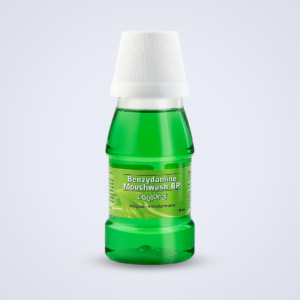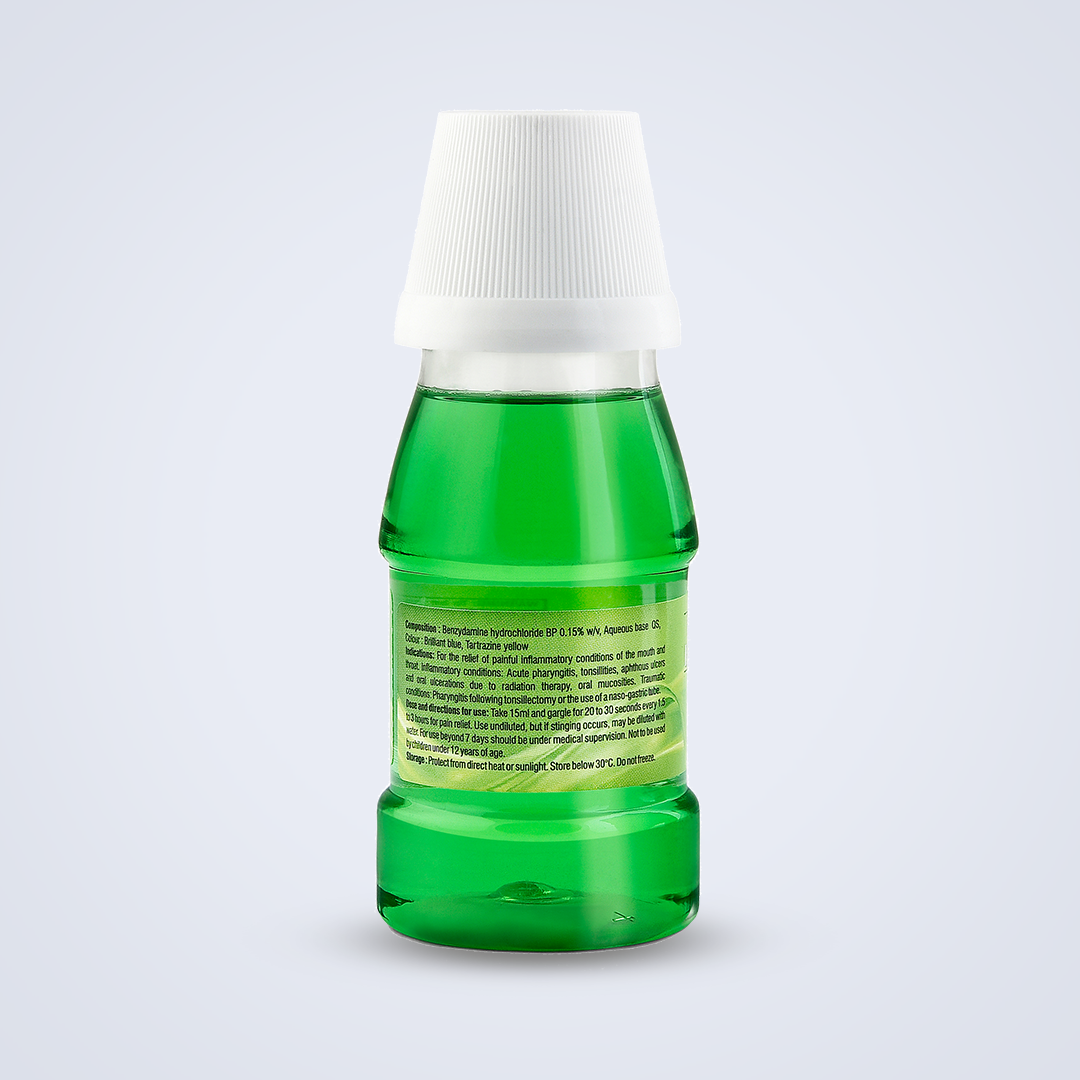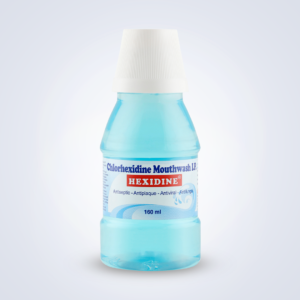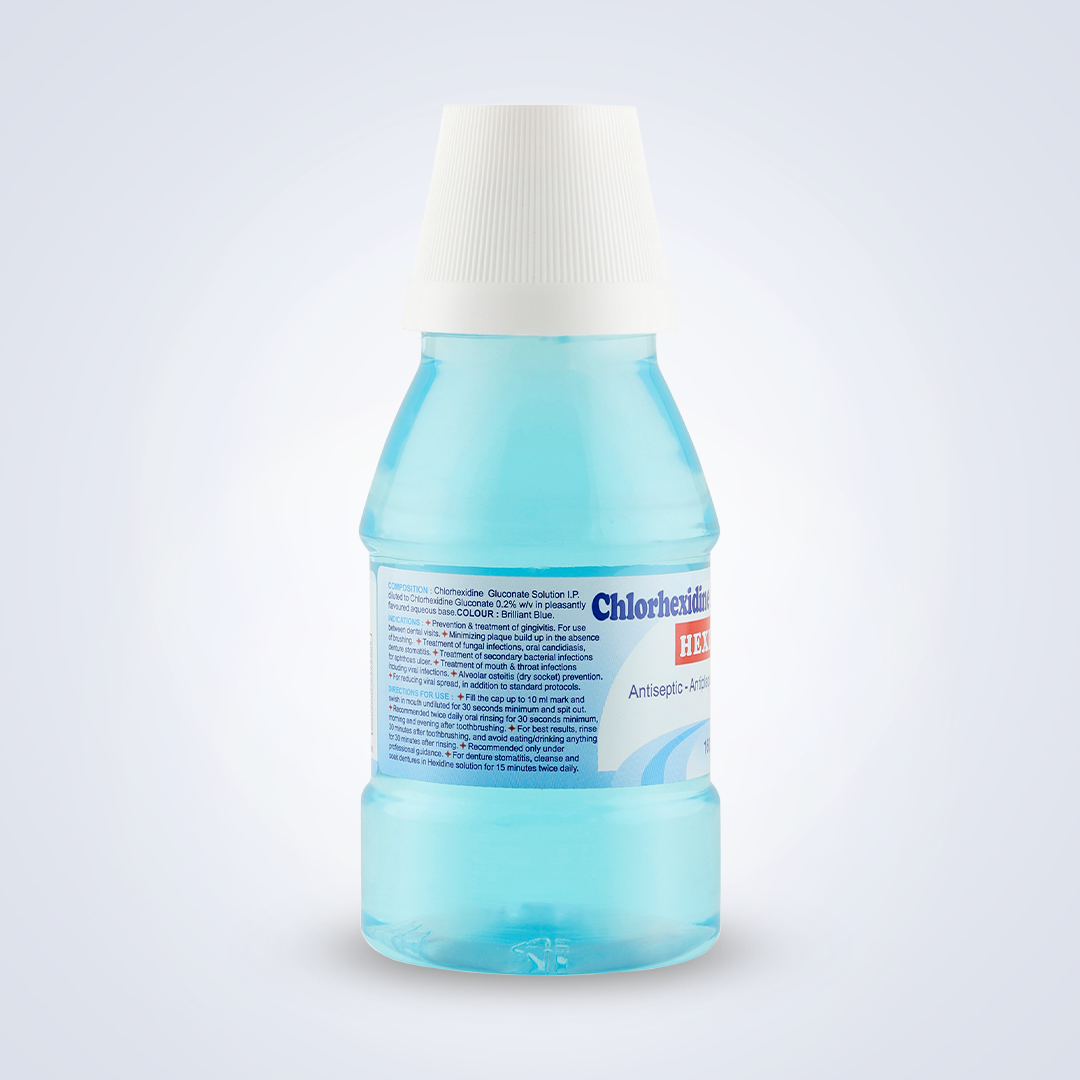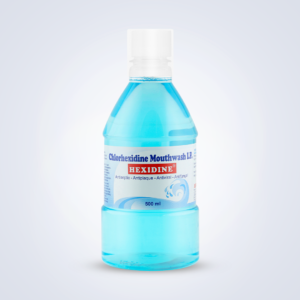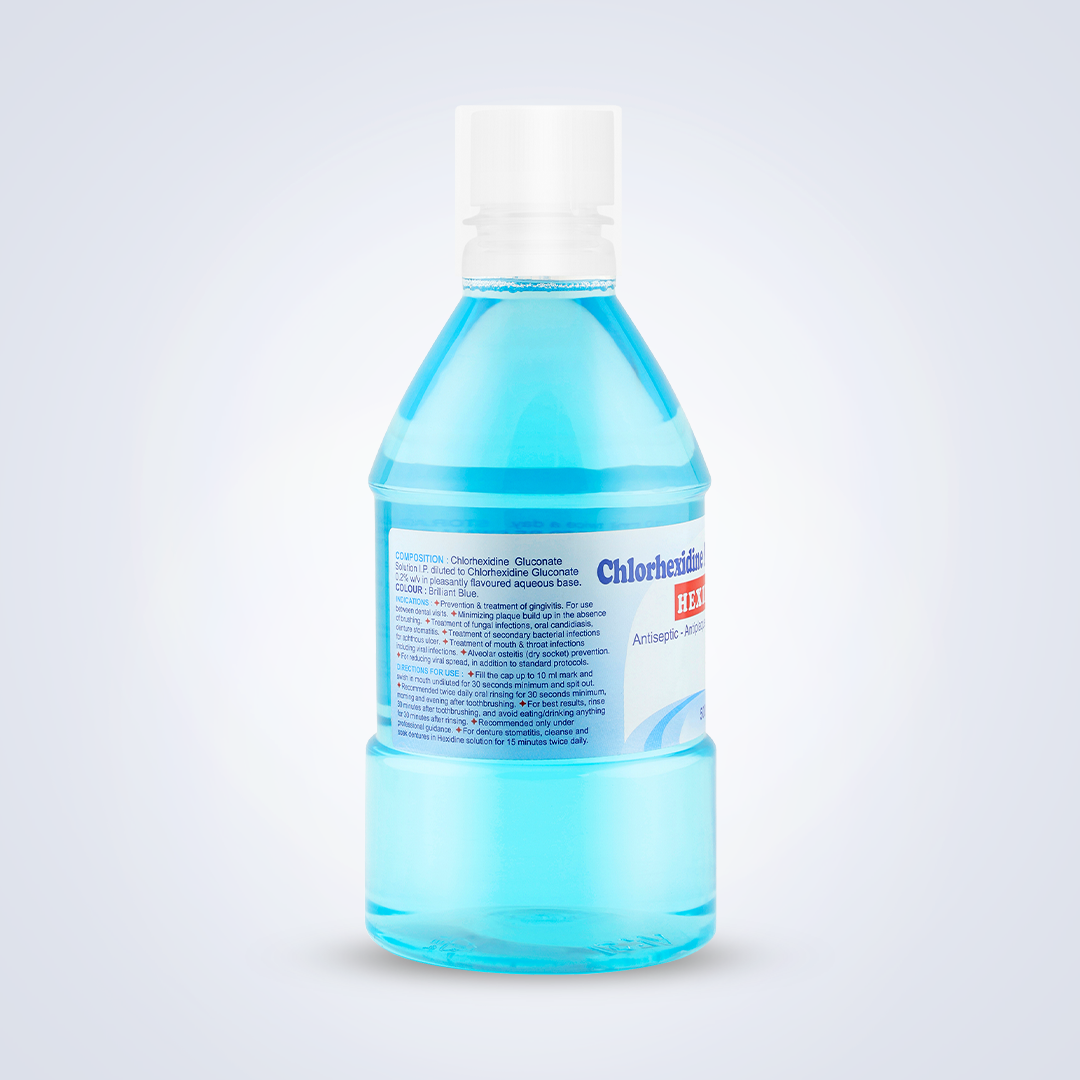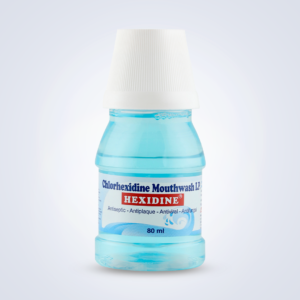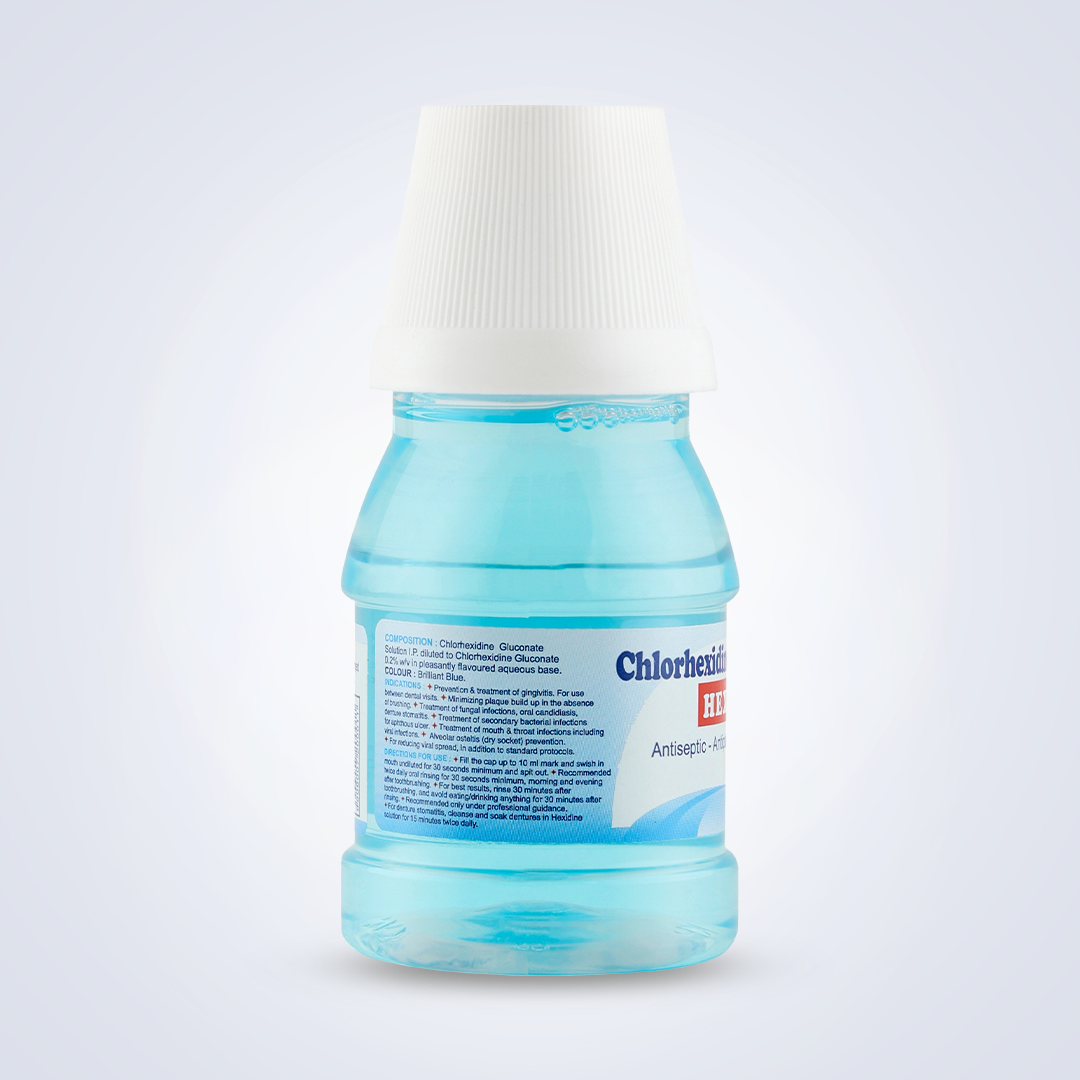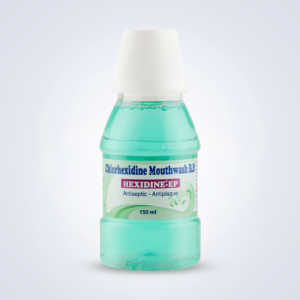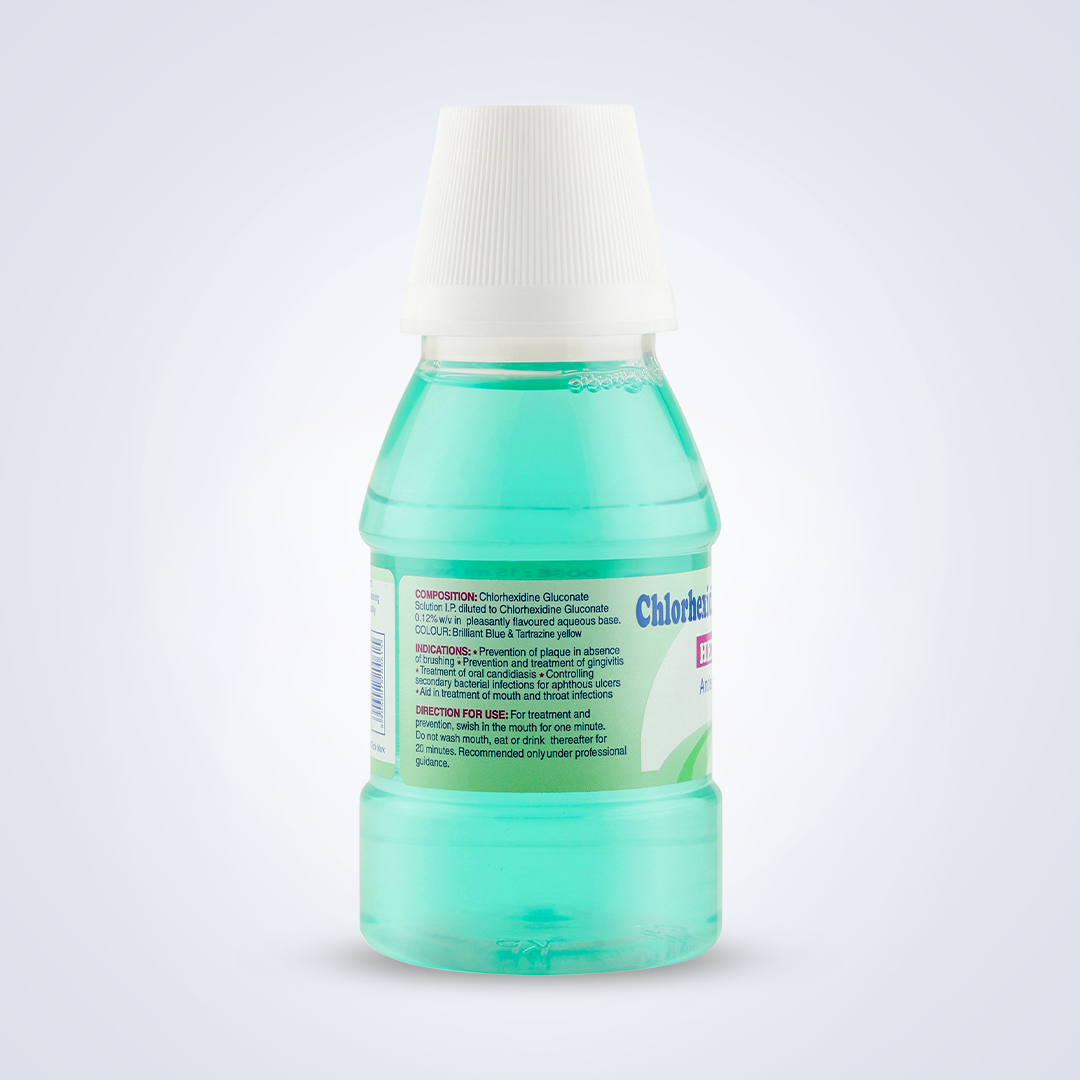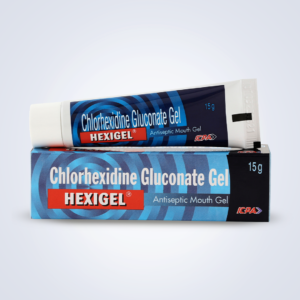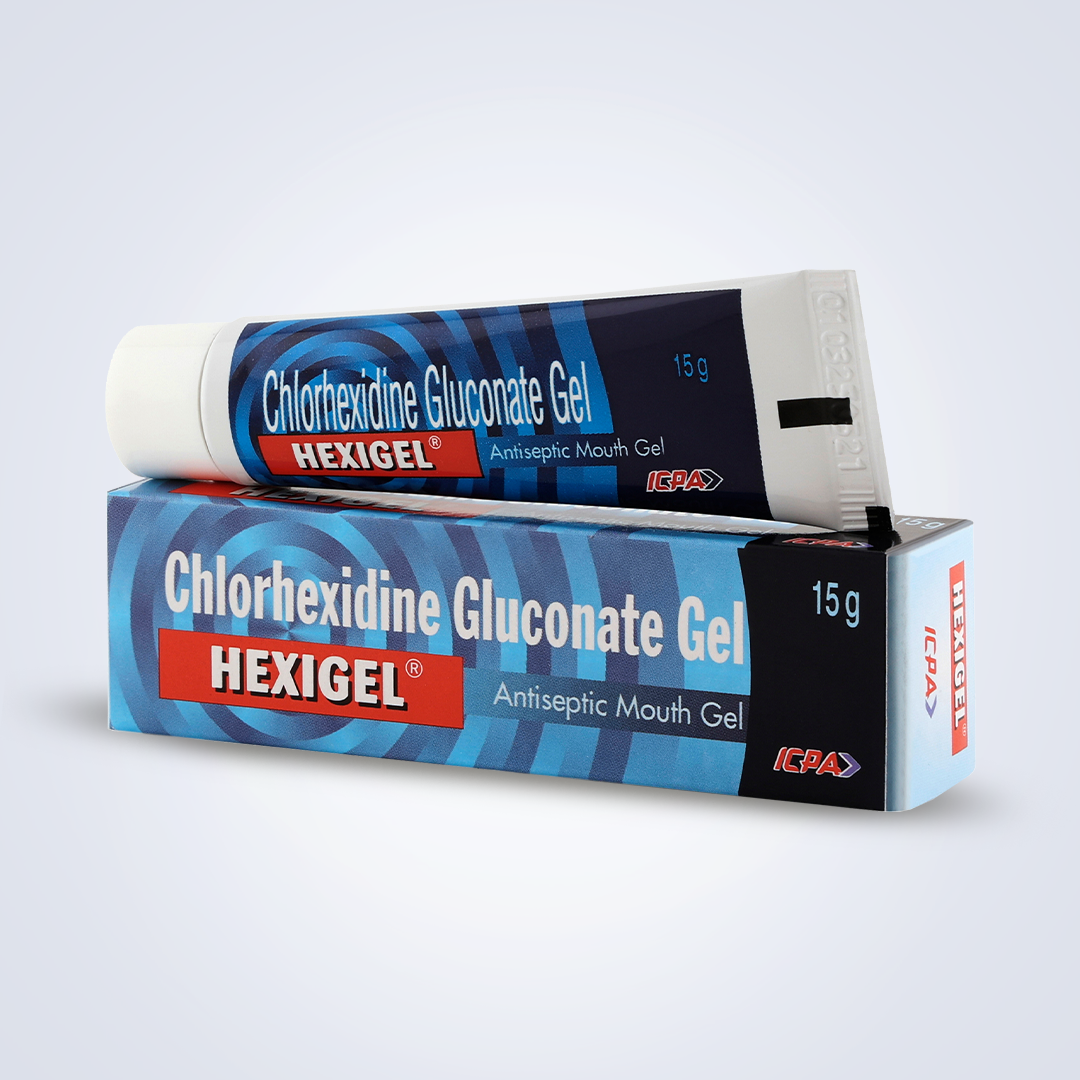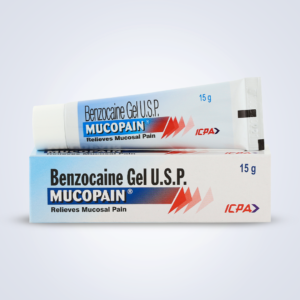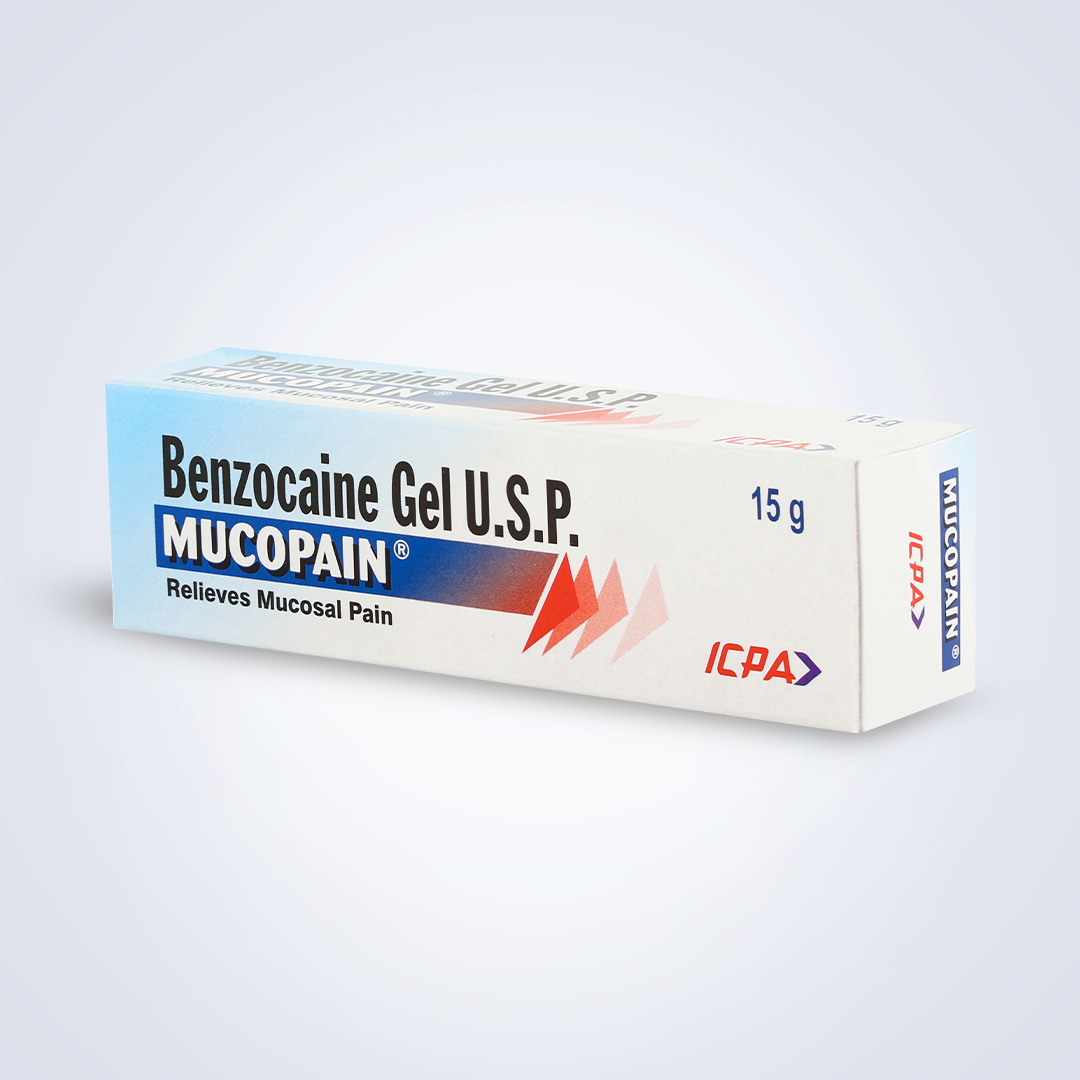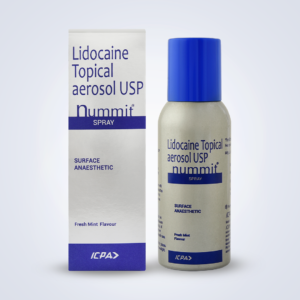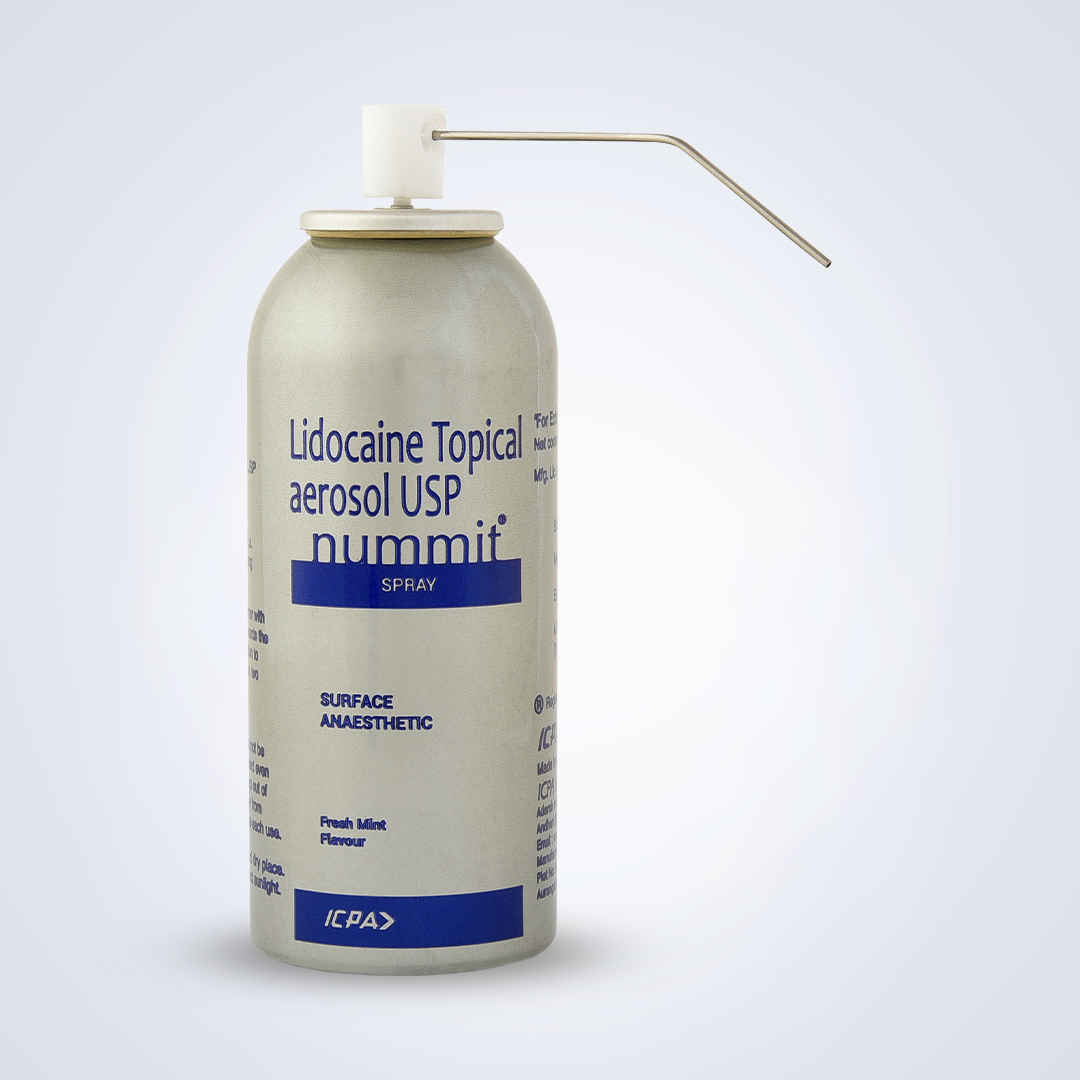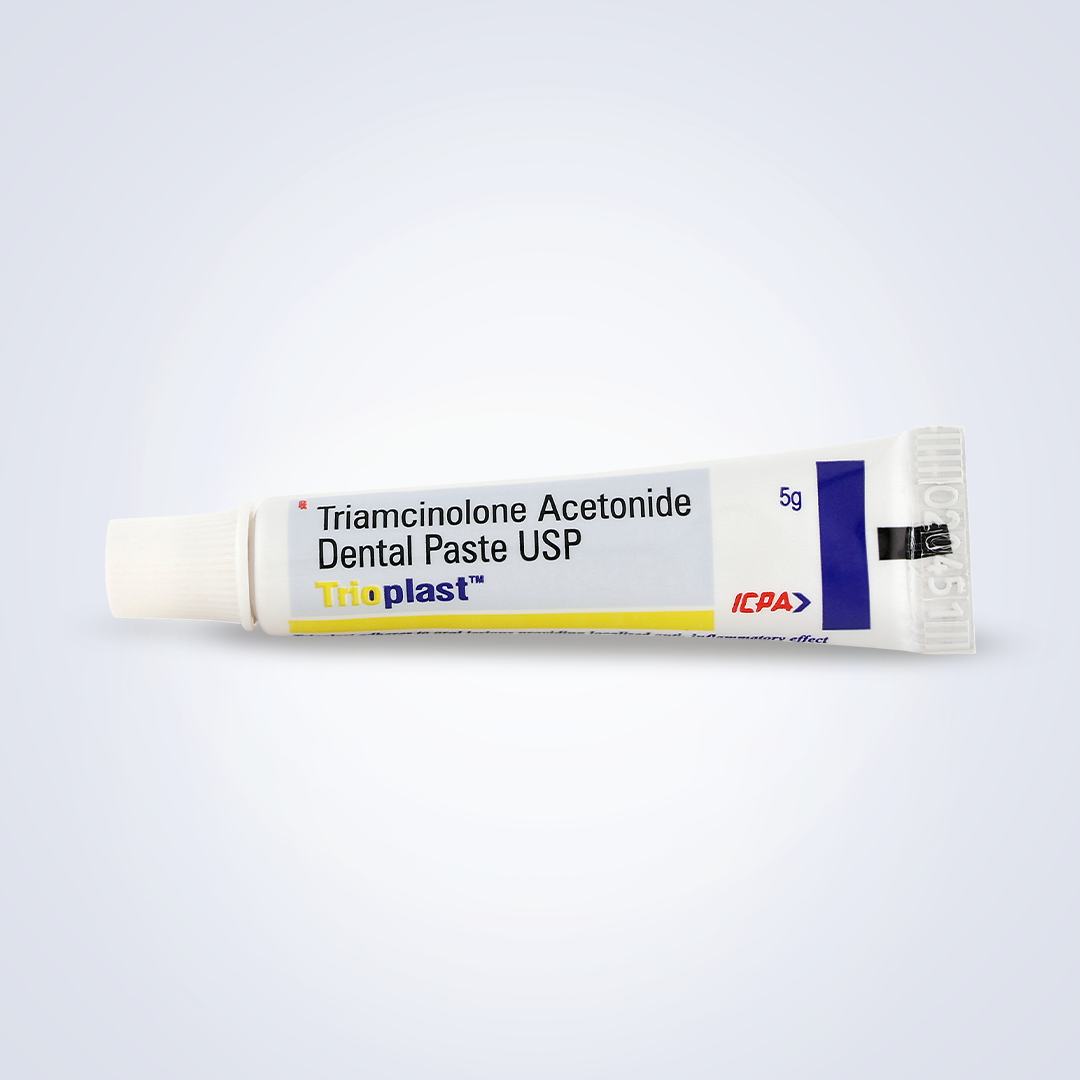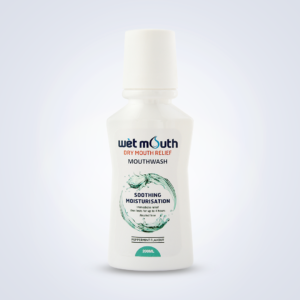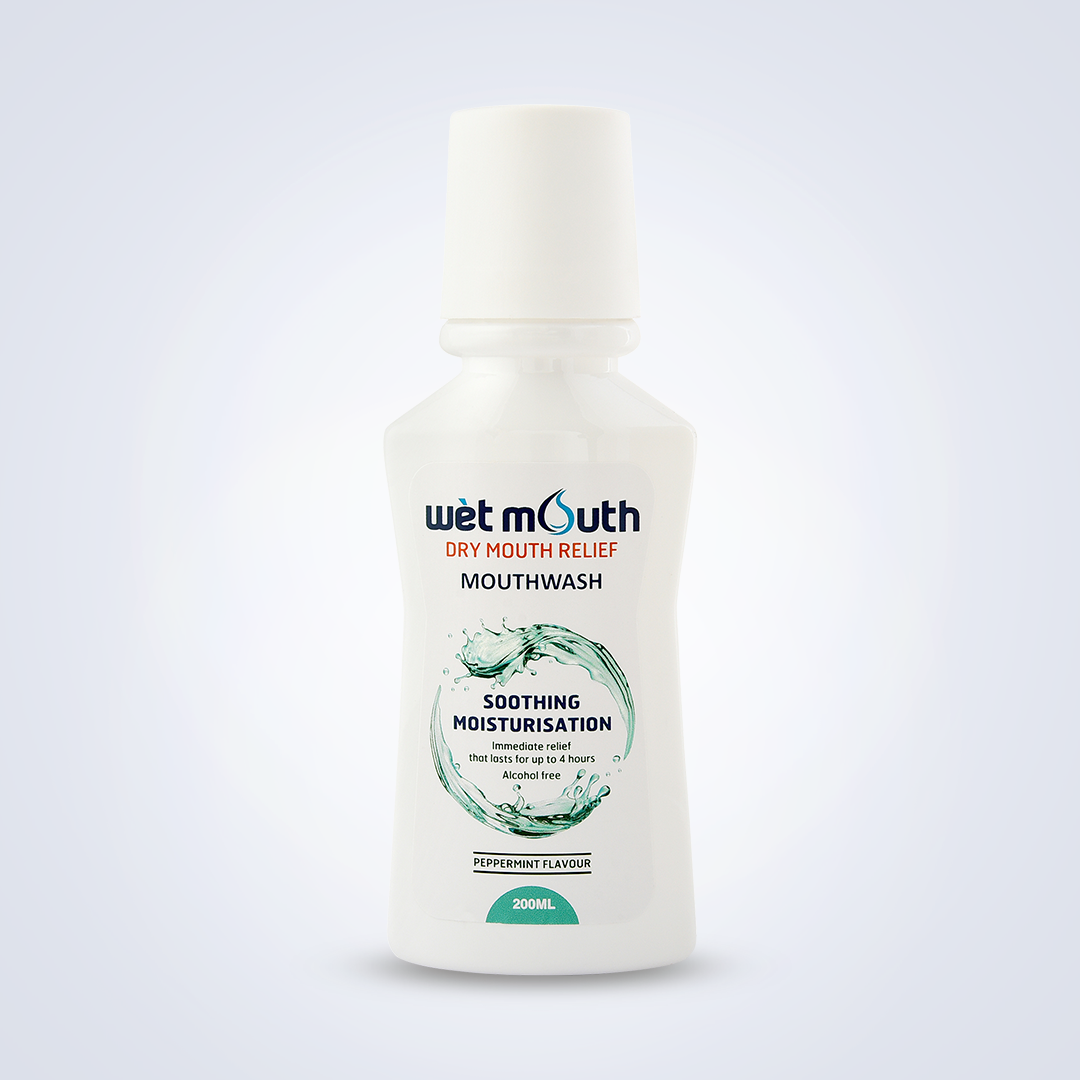ENT
ENT
Showing all 10 results
-
Coolora 100ml
Read More Quick ViewComposition:
Benzydamine hydrochloride BP 0.15 %w/v with Brilliant Blue and Tartarazine Yellow color in Aqueous base
Understanding Benzydamine hydrochloride:
Benzydamine hydrochloride is an anti-inflammatory, analgesic with anaesthetic action that can provide instant relief from a variety of painful inflammatory conditions of the oropharyngeal region when used as a rinse/ gargle.
Benzydamine shows some properties that are common with other nonsteroidal antiinflammatory drugs (NSAIDs) but also displays properties which are different from other NSAIDs.
Ref: Segre G, Hammarström S. Aspects of the mechanisms of action of benzydamine.
Int J Tissue React. 1985;7(3):187-93. PMID: 4044146.
Link: https://pubmed.ncbi.nlm.nih.gov/4044146/
Benzydamine inhibits prostaglandin and thromboxane biosynthesis at high concentrations,
which can be reached by topical application of the drug.Ref: Segre G, Hammarström S. Aspects of the mechanisms of action of benzydamine.
Int J Tissue React. 1985;7(3):187-93. PMID: 4044146.
Link: https://pubmed.ncbi.nlm.nih.gov/4044146/
Benzydamine mouthwash is considered the gold standard among anti-inflammatory agents in the management of oral mucositis in cancer patients.
Ref: Benzydamine Oro-mucosal Solution in Oral Mucositis. ClinicalTrials.gov
(NCT05055726), NIH U.S. National Library of Medicine, Sept 2021
Link:https://clinicaltrials.gov/ct2/show/NCT05055726
International guidelines and recommendations for Oral Mucositis (OM): Benzydamine is recommended
International guidelines in the management of oral mucositis were published in 2004 and then updated in 2007 and 2014. The Multinational Association of Supportive Care in Cancer and International SocietyOral Oncology (MASCC/ISOO) clinical practice guidelines (2014)recommend that benzydamine mouthwash be used to prevent OM in patients with cancer (level I evidence) – this is in agreement with the meta-analyses conducted in 2020.
Ref: Lalla RV, Bowen J, Barasch A, Elting L, Epstein J, Keefe DM, McGuire DB, Migliorati C, Nicolatou- Galitis O, Peterson DE, Raber-Durlacher JE, Sonis ST, Elad S; Mucositis Guidelines Leadership Group of the Multinational Association of Supportive Care in Cancer and International Society of Oral Oncology (MASCC/ISOO). MASCC/ISOO clinical practice guidelines for the management of mucositis secondary to cancer therapy.
Cancer. 2014 May 15;120(10):1453-61. doi: 10.1002/cncr.28592. Epub 2014 Feb 25.
Erratum in: Cancer. 2015 Apr 15;121(8):1339. PMID: 24615748; PMCID: PMC4164022.
Bayesian network analysis (2020)
Chamomile, honey, curcumin and benzydamine mouthwashes may be the most advantageous in terms of the prevention of intolerable Oral Mucositis.
Ref: Zhang X, Sun D, Qin N, Liu M, Zhang J, Li X. Comparative prevention potential of 10 mouthwashes on intolerable oral mucositis in cancer patients: A Bayesian network analysis. Oral Oncol. 2020 Aug;107:104751. doi: 10.1016/j.oraloncology.2020.104751.
Epub 2020 May 7. PMID: 32388411.
Link: https://www.sciencedirect.com/science/article/abs/pii/S1368837520301871
Network Meta-analysis (2020)
A total of 28 RCTs involving 1861 patients were included. The results of network meta- analysis showed that chlorhexidine, benzydamine, honey, and curcumin were more effective than placebo (P < 0.05).
Ref: Yu YT, Deng JL, Jin XR, Zhang ZZ, Zhang XH, Zhou X. Effects of 9 oral care solutions on the prevention of oral mucositis: a network meta-analysis of randomized controlledtrials. Medicine (Baltimore). 2020 Apr;99(16):e19661. doi: 10.1097/MD.0000000000019661.
PMID: 32311938; PMCID: PMC7220734.Benzydamine mouthwash is the only anti-inflammatory agent with evidence in the prevention of Oral Mucositis to date.
Ref: Ariyawardana A, Cheng KKF, Kandwal A, Tilly V, Al-Azri AR, Galiti D, Chiang K, Vaddi A, Ranna V, Nicolatou- Galitis O, Lalla RV, Bossi P, Elad S; Mucositis Study Group of the
Multinational Association of Supportive Care in Cancer/International Society for Oral Oncology (MASCC/ISOO). Systematic review of anti-inflammatory agents for the management of oral mucositis in cancer patients and clinical practice guidelines.
Support Care Cancer. 2019 Oct;27(10):3985-3995. doi: 10.1007/s00520-019-04888-w.
Epub 2019 Jul 8. PMID: 31286230.
Clinical indications:
1. Burning mouth due to various types of desquamative gingivitis: Lichen planus, pemphigoid types, pemphigus, and more
2. Burning mouth due to oral submucous fibrosis
3. Various red & white lesions affecting the oral mucosa.
4. Generalized oropharyngeal ulcers due to nutritional deficiency or infections.
5. Oral mucositis during and after cancer therapy.
6. Multiple oral mucosal injuries due to orthodontic appliances, oral surgery appliances
7. Painful sore throat, painful dysphagia.Coolora rinse / gargle provides instant relief from painful inflammatory conditions of the oro-pharyngeal region and helps patients get back on track with their essential life activities, such as eating, drinking, speaking, swallowing, etc.
Dosage & Administration:
Adults and Elderly:
Rinse or gargle with 15 ml (approximately 1 tablespoonful) every 11⁄2 to 3 hours as required for pain relief. The solution should be expelled from the mouth after use. Professional advice recommended. CHILDREN: Not suitable for children aged 12 years or under.
Presentation:
PET bottles of 100ml with 15ml measuring cap.
-
Hexidine 160ml
Read More Quick ViewComposition:
Chlorhexidine gluconate solution I.P. diluted to chlorhexidine gluconate 0.2% w/v in a pleasantly flavoured base.
Understanding Chlorhexidine gluconate:
1. Chlorhexidine (CHX) is known as the gold standard antiplaque agent because of its persistent attachment and sustained release for long Antiseptic, Antiplaque, Antiviral, Antifungal action.
2. Five decades of evidence for the antibacterial, antiviral, antifungal action.
3. Chlorhexidine’s antiplaque effect is because of its dicationic nature, which confers it the property of substantivity— persistent antimicrobial action through bactericidal and bacteriostatic effects.Mechanism of action:
1. Chlorhexidine is a symmetric bis-biguanide molecule carrying two positive charges at physiological pH. Due to its cationic properties, chlorhexidine binds to negatively charged sites within the plaque biofilm including the bacteria, extracellular polysaccharides, and glycoproteins.
2. The cationic chlorhexidine molecule gets rapidly attracted to the surface of a negatively charged bacterial cell wall, where it binds with specific and strong adsorption to phosphate-containing components of the bacterial cell wall.
3. Due to the strong binding, chlorhexidine passively diffuses through the bacterial cell wall.
4. First, chlorhexidine damages the outer cell membrane compromising the cell integrity, which allows chlorhexidine to infiltrate the inner cell membrane, resulting in greater permeability.
5. This infiltration results in an outflow of low-molecular-weight molecules and cytoplasmic components escaping from the bacterial cell.
6. At this point, chlorhexidine’s antimicrobial action remains bacteriostatic, which can be reversed if chlorhexidine is removed. However, if the chlorhexidine concentration remains stable over time or increases, it can cause irreversible cell damage via bactericidal action.
7. The bactericidal action involves cytoplasmic coagulation and precipitation, where chlorhexidine forms complexes with phosphorylated compounds, such as ATP and nucleic acids.
8. The dicationic chlorhexidine exhibits good adherence to most oral surfaces (including mucous membranes, teeth, and salivary glycoproteins) due to their negative charge, thus interfering with bacterial adhesion, allowing substantivity for up to 12 hours.Chlorhexidine the Gold standard antiplaque agent
1. Chlorhexidine is the gold standard when it comes to substantivity, which explains its superior
anti-plaque effect because of its superior degree of persistence at the tooth surface (hydroxyapatite) or, more correctly, the superior persistence of its antibacterial effect (both bactericidal and bacteriostatic) at the tooth surface.
2. Chlorhexidine comes under Group A mouthwashes with good substantivity (prolonged action) as well as action on a wide spectrum of bacteria. The only category of mouth rinses belonging to this group are bisguanides (Chlorhexidine). The true anti-plaque effect of Chlorhexidine empowers it to replace mechanical cleaning for short periods when tooth brushing is not possible.Indications:
1. Prevention & treatment of gingivitis. For home use between periodontal treatment visits.
2. Minimizing plaque build up in the absence of brushing.
3. Fungal infections of the mouth: oral candidiasis, denture stomatitis.
4. Secondary bacterial infections for aphthous ulcer.
5. Rinsing & gargling for oropharyngeal viral infections.
6. Alveolar osteitis (dry socket) prevention.
7. Reducing viral spread from oropharyngeal region by reducing the viral load
8. As a pre-procedural rinse before dental procedures.
9. Patients undergoing cancer therapy who can not perform mechanical plaque control due to pain and discomfort in the gingiva and oral mucosa.
10. Post-surgical mouthwash: If toothbrushing is not possible due to postoperative pain after any type of oral, periodontal, soft tissue surgery, or extractions, it is recommended that a 1-minute rinse is performed 3 times a day for 7 days or until sutures are removed and oral hygiene in the form of toothbrushing can resume.Directions for use:
1. Recommended only under professional guidance.
2. Recommended twice daily oral rinsing for 30 seconds at least, morning and evening after toothbrushing. Fill the cap up to 10 ml mark and swish in mouth undiluted for 30 seconds at least, and spit out.
3. For best results, rinse at least 30 minutes after toothbrushing, and avoid eating / drinking for at least 30 minutes after rinsing.
4. For denture stomatitis, cleanse and soak dentures in chlorhexidine mouthwash solution for 15 minutes twice daily.
5. Prolonged use may cause temporary staining of teeth, removed by oral prophylaxis. This usually disappears once the treatment is over, or may require scaling/ polishing. However, staining is known to occur only after continuously using for 4 weeks or more.Presentation:
PET bottles of 80ml (2.7 fl.oz.), 160ml (5.41 fl.oz.) with 10ml measuring cap. Plastic bottle of 500 ml (16.9 fl. oz.).
Caution:
Not to be swallowed. For oral use only.
-
Hexidine 500ml
Read More Quick ViewComposition:
Chlorhexidine gluconate solution I.P. diluted to chlorhexidine gluconate 0.2% w/v in a pleasantly flavoured base.
Understanding Chlorhexidine gluconate:
1. Chlorhexidine (CHX) is known as the gold standard antiplaque agent because of its persistent attachment and sustained release for long Antiseptic, Antiplaque, Antiviral, Antifungal action.
2. Five decades of evidence for the antibacterial, antiviral, antifungal action.
3. Chlorhexidine’s antiplaque effect is because of its dicationic nature, which confers it the property of substantivity— persistent antimicrobial action through bactericidal and bacteriostatic effects.Mechanism of action:
1. Chlorhexidine is a symmetric bis-biguanide molecule carrying two positive charges at physiological pH. Due to its cationic properties, chlorhexidine binds to negatively charged sites within the plaque biofilm including the bacteria, extracellular polysaccharides, and glycoproteins.
2. The cationic chlorhexidine molecule gets rapidly attracted to the surface of a negatively charged bacterial cell wall, where it binds with specific and strong adsorption to phosphate-containing components of the bacterial cell wall.
3. Due to the strong binding, chlorhexidine passively diffuses through the bacterial cell wall.
4. First, chlorhexidine damages the outer cell membrane compromising the cell integrity, which allows chlorhexidine to infiltrate the inner cell membrane, resulting in greater permeability.
5. This infiltration results in an outflow of low-molecular-weight molecules and cytoplasmic components escaping from the bacterial cell.
6. At this point, chlorhexidine’s antimicrobial action remains bacteriostatic, which can be reversed if chlorhexidine is removed. However, if the chlorhexidine concentration remains stable over time or increases, it can cause irreversible cell damage via bactericidal action.
7. The bactericidal action involves cytoplasmic coagulation and precipitation, where chlorhexidine forms complexes with phosphorylated compounds, such as ATP and nucleic acids.
8. The dicationic chlorhexidine exhibits good adherence to most oral surfaces (including mucous membranes, teeth, and salivary glycoproteins) due to their negative charge, thus interfering with bacterial adhesion, allowing substantivity for up to 12 hours.Chlorhexidine the Gold standard antiplaque agent
1. Chlorhexidine is the gold standard when it comes to substantivity, which explains its superior
anti-plaque effect because of its superior degree of persistence at the tooth surface (hydroxyapatite) or, more correctly, the superior persistence of its antibacterial effect (both bactericidal and bacteriostatic) at the tooth surface.
2. Chlorhexidine comes under Group A mouthwashes with good substantivity (prolonged action) as well as action on a wide spectrum of bacteria. The only category of mouth rinses belonging to this group are bisguanides (Chlorhexidine). The true anti-plaque effect of Chlorhexidine empowers it to replace mechanical cleaning for short periods when tooth brushing is not possible.Indications:
1. Prevention & treatment of gingivitis. For home use between periodontal treatment visits.
2. Minimizing plaque build up in the absence of brushing.
3. Fungal infections of the mouth: oral candidiasis, denture stomatitis.
4. Secondary bacterial infections for aphthous ulcer.
5. Rinsing & gargling for oropharyngeal viral infections.
6. Alveolar osteitis (dry socket) prevention.
7. Reducing viral spread from oropharyngeal region by reducing the viral load
8. As a pre-procedural rinse before dental procedures.
9. Patients undergoing cancer therapy who can not perform mechanical plaque control due to pain and discomfort in the gingiva and oral mucosa.
10. Post-surgical mouthwash: If toothbrushing is not possible due to postoperative pain after any type of oral, periodontal, soft tissue surgery, or extractions, it is recommended that a 1-minute rinse is performed 3 times a day for 7 days or until sutures are removed and oral hygiene in the form of toothbrushing can resume.Directions for use:
1. Recommended only under professional guidance.
2. Recommended twice daily oral rinsing for 30 seconds at least, morning and evening after toothbrushing. Fill the cap up to 10 ml mark and swish in mouth undiluted for 30 seconds at least, and spit out.
3. For best results, rinse at least 30 minutes after toothbrushing, and avoid eating / drinking for at least 30 minutes after rinsing.
4. For denture stomatitis, cleanse and soak dentures in chlorhexidine mouthwash solution for 15 minutes twice daily.
5. Prolonged use may cause temporary staining of teeth, removed by oral prophylaxis. This usually disappears once the treatment is over, or may require scaling/ polishing. However, staining is known to occur only after continuously using for 4 weeks or more.Presentation:
PET bottles of 80ml (2.7 fl.oz.), 160ml (5.41 fl.oz.) with 10ml measuring cap. Plastic bottle of 500 ml (16.9 fl. oz.).
Caution:
Not to be swallowed. For oral use only.
-
Hexidine 80ml
Read More Quick ViewComposition:
Chlorhexidine gluconate solution I.P. diluted to chlorhexidine gluconate 0.2% w/v in a pleasantly flavoured base.
Understanding Chlorhexidine gluconate:
1. Chlorhexidine (CHX) is known as the gold standard antiplaque agent because of its persistent attachment and sustained release for long Antiseptic, Antiplaque, Antiviral, Antifungal action.
2. Five decades of evidence for the antibacterial, antiviral, antifungal action.
3. Chlorhexidine’s antiplaque effect is because of its dicationic nature, which confers it the property of substantivity— persistent antimicrobial action through bactericidal and bacteriostatic effects.Mechanism of action:
1. Chlorhexidine is a symmetric bis-biguanide molecule carrying two positive charges at physiological pH. Due to its cationic properties, chlorhexidine binds to negatively charged sites within the plaque biofilm including the bacteria, extracellular polysaccharides, and glycoproteins.
2. The cationic chlorhexidine molecule gets rapidly attracted to the surface of a negatively charged bacterial cell wall, where it binds with specific and strong adsorption to phosphate-containing components of the bacterial cell wall.
3. Due to the strong binding, chlorhexidine passively diffuses through the bacterial cell wall.
4. First, chlorhexidine damages the outer cell membrane compromising the cell integrity, which allows chlorhexidine to infiltrate the inner cell membrane, resulting in greater permeability.
5. This infiltration results in an outflow of low-molecular-weight molecules and cytoplasmic components escaping from the bacterial cell.
6. At this point, chlorhexidine’s antimicrobial action remains bacteriostatic, which can be reversed if chlorhexidine is removed. However, if the chlorhexidine concentration remains stable over time or increases, it can cause irreversible cell damage via bactericidal action.
7. The bactericidal action involves cytoplasmic coagulation and precipitation, where chlorhexidine forms complexes with phosphorylated compounds, such as ATP and nucleic acids.
8. The dicationic chlorhexidine exhibits good adherence to most oral surfaces (including mucous membranes, teeth, and salivary glycoproteins) due to their negative charge, thus interfering with bacterial adhesion, allowing substantivity for up to 12 hours.Chlorhexidine the Gold standard antiplaque agent
1. Chlorhexidine is the gold standard when it comes to substantivity, which explains its superior
anti-plaque effect because of its superior degree of persistence at the tooth surface (hydroxyapatite) or, more correctly, the superior persistence of its antibacterial effect (both bactericidal and bacteriostatic) at the tooth surface.
2. Chlorhexidine comes under Group A mouthwashes with good substantivity (prolonged action) as well as action on a wide spectrum of bacteria. The only category of mouth rinses belonging to this group are bisguanides (Chlorhexidine). The true anti-plaque effect of Chlorhexidine empowers it to replace mechanical cleaning for short periods when tooth brushing is not possible.Indications:
1. Prevention & treatment of gingivitis. For home use between periodontal treatment visits.
2. Minimizing plaque build up in the absence of brushing.
3. Fungal infections of the mouth: oral candidiasis, denture stomatitis.
4. Secondary bacterial infections for aphthous ulcer.
5. Rinsing & gargling for oropharyngeal viral infections.
6. Alveolar osteitis (dry socket) prevention.
7. Reducing viral spread from oropharyngeal region by reducing the viral load
8. As a pre-procedural rinse before dental procedures.
9. Patients undergoing cancer therapy who can not perform mechanical plaque control due to pain and discomfort in the gingiva and oral mucosa.
10. Post-surgical mouthwash: If toothbrushing is not possible due to postoperative pain after any type of oral, periodontal, soft tissue surgery, or extractions, it is recommended that a 1-minute rinse is performed 3 times a day for 7 days or until sutures are removed and oral hygiene in the form of toothbrushing can resume.Directions for use:
1. Recommended only under professional guidance.
2. Recommended twice daily oral rinsing for 30 seconds at least, morning and evening after toothbrushing. Fill the cap up to 10 ml mark and swish in mouth undiluted for 30 seconds at least, and spit out.
3. For best results, rinse at least 30 minutes after toothbrushing, and avoid eating / drinking for at least 30 minutes after rinsing.
4. For denture stomatitis, cleanse and soak dentures in chlorhexidine mouthwash solution for 15 minutes twice daily.
5. Prolonged use may cause temporary staining of teeth, removed by oral prophylaxis. This usually disappears once the treatment is over, or may require scaling/ polishing. However, staining is known to occur only after continuously using for 4 weeks or more.Presentation:
PET bottles of 80ml (2.7 fl.oz.), 160ml (5.41 fl.oz.) with 10ml measuring cap. Plastic bottle of 500 ml (16.9 fl. oz.).
Caution:
Not to be swallowed. For oral use only.
-
Hexidine EP 150ml
Read More Quick ViewChlorhexidine Mouthwash IP/BP
Composition:
Chlorhexidine gluconate solution I.P. dilute to chlorhexidine gluconate 0.12% W/V in pleasantly flavored aqueous base.COLOR:
Brilliant Blue & Tartrazine YellowIndications:
- Prevention of plaque in absence of brushing
- Prevention and treatment of gingivitis
- Treatment of oral candidiasis
- Controlling secondary bacterial infections for aphthous ulcers
- Aid in treatment of mouth and throat infections
DIRECTION FOR USE:
For treatment and prevention, swish in your mouth for one minute. Do not rinse, eat or drink thereafter for 20 minutes. Recommended only under professional guidance.DOSE:
10ml, twice a day.STORAGE:
Keep out of direct sun light.WARNING:
NOT TO BE SWALLOWED. FOR ORAL USE ONLY. Brown staining of teeth may be reported, while using the product in some cases. This usually disappears once the treatment is over or may require scaling/polishing. Remove foil before use.
Net content: 150 ml/500 ml
-
Hexigel 15gm
Read More Quick ViewComposition:
Chlorhexidine gluconate solution I.P. equivalent to chlorhexidine gluconate 1.0% w/w in pleasantly flavoured base.
The use of Chlorhexidine gel:
The application of chlorhexidine (CHX) gel on ulcers and wound surfaces after oral surgical procedures has received considerable attention— supported scientifically by the antimicrobial properties of chlorhexidine.
Chlorhexidine acts against bacteria (Gram-positive and Gram-negative), with bacteriostatic action at low concentrations and bactericidal action at high concentrations Chlorhexidine is also known for its antiviral and antifungal effects.Mode of action:
Chlorhexidine acts on the target micro-organisms by increasing their cell membrane permeability which causes the precipitation of cytoplasmic macromolecules and subsequent microbial death via cell lysis. Therefore, the effect of CHX is mainly based on minimizing the microbial load —playing an anti-infection role, which seems critical in the early stages of wound healing.
Indications:
1. Periodontal diseases: gingivitis, periodontitis
2. Oral candidiasis, esp denture stomatitis
3. Aphthous and other oral ulcers, such as due to dentures
4. Common oral injuries, including those from orthodontic appliances and oral surgery appliances
5. Maintenance of oral hygiene, especially interdentally — in cancer patients, gingivitis & periodontitis patients, between and around restorationsScientific basis in various clinical applications:
A. Hexigel in the prevention of alveolar osteitis (dry socket)
The extraction of third molars is a common dental procedure. The American Association of Oral and Maxillofacial Surgeons states that “about 85% of third molars will eventually need to be removed”.
Available data also shows that 5 to 30% third molar extractions can create a”dry socket” – a complication associated with severe pain.
How can we prevent this unwanted complication?
1. A meta-analysis published in “Oral Diseases” in August 2016, reviewed 11 trials and found that 0.2% chlorhexidine gel was effective in preventing alveolar osteitis after lower third molar extraction(s).
https://onlinelibrary.wiley.com/doi/abs/10.1111/odi.12553
2. Journal of Oral & Maxillofacial Surgery in May 2017, reviewed Twenty-three studies published from 1979 to 2015 and concluded that chlorhexidine, used in any formulation and concentration can prevent dry socket in patients who have undergone third molar extraction. https://www.joms.org/article/S0278-2391(17)30020-4/fulltext
3. Another systematic review & meta-analysis published in May 2017 found that Chlorhexidine gel is superior to placebo in reducing the incidence of alveolar osteitis after mandibular third molar extraction.
https://bmcoralhealth.biomedcentral.com/articles/10.1186/s12903-017-0376-3
4. The largest network meta-analysis done till now reviewed 37 randomized controlled trials that included 6175 mandibular third molar surgeries in 4716 patients. This study published in Sept 2020 showed that 0.2% Chlorhexidine gel placed in the socket can prevent dry socket after mandibular third molar surgery.
https://www.sciencedirect.com/science/article/abs/pii/S1010518220301578
Hexigel, a 1% Chlorhexidine gluconate-based gel, is an inexpensive and easily available local application for all the 3rd molar extraction patients. They can apply it multiple times a day from the day of tooth extraction. A single tube of Hexigel contains enough quantity of gel to give protective coverage during the critical phase of the first couple of days.Use Hexigel after every case of lower molar extraction, especially the surgical extraction of the lower wisdom tooth, and minimize the risk of dry socket.
B. Hexigel as a post-surgical gel
High-quality articles demonstrate the evidence that Chlorhexidine gel application
exerts a beneficial effect on oral surgical wound healing. Chlorhexidine gel
application significantly decreases the risk of surgical complications and/or poor
wound healing.C. Hexigel in denture stomatitis
Denture stomatitis (DS) seen in about 15-70% of denture wearers is a condition characterized by a generalized inflammation of the denture-covered palatal mucosa. The clinical signs can vary from petechiae to generalized inflammation with papillary hyperplasia.
It is a harmless form of oral candidiasis associated with a quantitative increase of yeasts (a mixture of Candida species eg. C. albicans, C. tropicalis, C. krusei, C. guilliermondii, C. glabrata) on the mucosa and the denture’s fit surface. Complete and removable dentures accumulate, among all, C. albicans on the porous surface of the acrylic resin.
Denture hygiene is an important factor in the prevention and treatment of DS. Chlorhexidine digluconate, an effective antimicrobial agent active against various bacteria, viruses, and fungi including C. albicans, is recommended in the treatment of denture stomatitis because of its proven clinical and microbiological efficacy.
D. Hexigel in cancer patients
Patients can use an interdental brush dipped in chlorhexidine gel to clean the areas between teeth, crowns, and bridges to ensure good oral health.
E. Hexigel in periodontitis patients
Cleaning the interdental areas is a critical component of oral care in periodontitis patients.
F. Hexigel in restorative dentistry
Restorations with overhangs and rough edges can create plaque-retentive areas around the crowns, bridges, and fillings. Cleaning the interdental areas is critical to maintaining soft tissue health interdentally. Cleaning the interdental areas is a critical component of oral care in periodontitis patients.
Directions for use:
For oral hygiene, plaque inhibition and gingivitis: Brush your teeth with the gel once or twice a day. Use an interdental brush for carrying hexigel between teeth, crowns, bridges, and implants. For management of aphthous and other oral ulcers: Apply the gel to affected areas once or twice a day.
Warning:
Brown staining may be reported with extensive use in some cases. It can be removed by brushing or polishing.
Presentation:
Lamitube of 15g (0.52 oz)
-
Mucopain 15gm
Read More Quick ViewComposition:
Benzocaine I.P. 20% w/w in a water-miscible base Topical anaesthetics come in various dosage forms, such as gels, sprays, creams, ointments, patches to provide the clinicians with precise options for application under various situations.
Understanding Benzocaine:
Benzocaine is an ester type molecule used for topical (surface) anaesthesia in a variety of settings, including dental procedures, preparation for infiltration anesthesia, and pain relief minor traumas to oral mucosa.
Topical anaesthetic agents such as Benzocaine penetrate the oral mucosa effectively and offer local anaesthetic activity that lasts for 10-20 minutes. The poor water solubility of Mucopain makes it safe for topical use. Local anaesthetics reversibly block nerve transmission, when applied to a limited area of the body. They bind to the sodium channels in the nerve membrane and prevent the entry of sodium ions in response to the membrane’s depolarization.
Mechanism of action:
1. Benzocaine acts by reversibly binding to and inhibiting sodium channels in the neuronal cell membrane.
2. Benzocaine first enters the cell in a nonionized form and then becomes ionized after traveling through the membrane bilayer.
3. Once ionized, benzocaine starts inhibiting the voltage-gated sodium channels by binding to their alpha subunit.
4. This binding stops cellular depolarization and minimizes the chances of action potential generation.
5. Benzocaine can bind more easily to sodium channels when they are in an open configuration.
6. The pKa value of local anesthetics is critical as it helps to determine their onset of action. Since benzocaine’s pKa value is relatively low (2.6) in comparison to other local anesthetics, its onset of action is quick, its rate of action is fast and relatively pH-independent.Indications:
For topical anaesthesia of all accessible mucous membrane, except eyes. For temporary local relief of pain associated with dental conditions and oropharyngeal disorders.
1. Nutritional deficiency induced ulcers
2. Traumatic ulcers, such as lip bite, cheek bite
3. Treatment induced ulcers: due to orthodontic appliances, oral surgical appliances, dentures
4. Mucosal injuries during instrumentation in dental procedures
5. Ulcers from autoimmune disorders, such as lichen planus, pemphigoid, pemphigus.
6. Oral submucous fibrosis (OSMF)
7. Oral ulcers in cancer patientsDirections for use:
For oral mucosal use only, as directed by a dentist. For the temporary relief of pain due to ulcers, or injuries from minor dental procedures.
Warning:
Discontinue medication and consult a doctor if sensitivity or irritation occurs. Safe use of Mucopain is not established during pregnancy on the foetus. Do not cover the affected area with cotton or other material. Not for infant use.
Methemoglobinemia warning
Use of this product may cause methemoglobinemia, a serious condition that warrants prompt clinical management because it reduces the amount of oxygen carried in the blood. This can occur even if one has used this product before. Stop use and seek immediate medical attention if you or a user in your care develops any of the following:
- pale, gray, or blue-colored skin (cyanosis)
- headache
- rapid heart rate
- shortness of breath
- dizziness or lightheadedness
- fatigue or lack of energy
Presentation:
Lamitube of 15g (0.52 oz)
-
Nummit Spray
Read More Quick ViewComposition:
Lidocaine U.S.P. 15% w/w Inert solvents & Propellant q.s. to 100% w/w Each actuation delivers 7.5mg of Lidocaine USP, CFC free.
Mode of action:
Local anesthetics like Lidocaine reversibly block nerve transmission, when applied to a limited area of the body. They bind to the sodium channels in the nerve membrane and prevent the entry of sodium ions in response to the membrane’s depolarization.
Indications:
Preoperative surface anesthesia and for painful oral conditions.
Directions for use:
Hold the container with the extension tube pointing towards the area of applications. Press the button to spray. Allow 2 seconds between two subsequent sprays. Shake the container before each use.
Caution:
Flammable, Pressurised container. Must not be punctured, broken, or incinerated, even when apparently empty. Keep out of reach of children. Keep away from eyes.
Storage:
Store in a cool and dry place. Keep away from heat and direct sunlight.
Presentation:
Metallic canister of 100 gm (3.52 oz)
-
Trioplast 5gm
Read More Quick ViewComposition:
Triamcinolone acetonide IPNSP 0.1%w/w, Oral paste – QS.
Preservatives: Methyl paraben IP/USP0.2%wlw, Propyl paraben IP/USP0.02%w/w. Triamcinolone Acetonide is a synthetic glucocorticoid with anti-inflammatory and immunosuppressive properties.Components that improve the action of Triamcinolone:
Retention: Carboxy Methyl Cellulose: Moisture retention for faster healing
Protection: Pectin: Gelling agent with protective coating
Release: Gelatin facilitates controlled release of steroid
Clinical conditions:
Recurrent Aphthous Stomatitis (RAS)
Recurrent aphthous stomatitis (RAS), commonly known as “canker sores”, is a form of benign inflammation of the oral mucosa. Although the term “canker sores” is commonly used to describe any abnormality of the mouth, the term, strictly refers to painful oral ulcers that come and go over time.
Recurrent aphthous stomatitis affects 1 in 5 persons and usually begins in adolescence and teenage years. During an episode, it may present with 1-5 painful ulcers that last for 1 – 2 weeks. These ulcers are typically seen on the inner cheeks, inner lips, underside of the tongue, or soft palate. Just before the appearance of an ulcer, one may feel a burning sensation or a lump in the area. Ulcers may be considered minor if they are less than 1⁄2 inch and heal in less than two weeks without scarring. They are called major if they are greater than 1⁄2 inch, take longer than two weeks to heal and leave scars. Some patients may have multiple recurrent crops of small, pinpoint, painful ulcers known as herpetiform RAS (these ulcers are not related to herpes virus infection). Patients are considered to have severe RAS when they have continuous ulcers with few, if any, ulcer-free periods, regardless of the size and/ or number of lesions.
Desquamative Gingivitis
The term “desquamative” comes from the Latin word “desquamare,” meaning to scrape fish scales. Desquamation refers to the shedding of epithelium, leading to skin or mucous membrane exfoliation. Desquamative gingivitis (DG) is a clinical description of gingiva marked by severe redness, peeling, vesicles, or bullae that can result in ulcers. It affects both the free and attached gingival mucosa. DG represents a clinical manifestation of various diseases.
The most common culprits include dermatological conditions like lichen planus (LP) in 70-75% of cases, cicatricial pemphigoid (CP) in 9-14% of cases, and pemphigus vulgaris (PV) in 4-13% of cases.
Oral Submucous Fibrosis
Oral submucous fibrosis (OSMF) is a precancerous condition with chances of malignant transformation in 1.5–15% of the cases. OSMF is mainly caused by chewing betel nut, which is accelerated by addition of tobacco. Other risk factors include genetic predisposition, autoimmunity, nutritional deficiencies, human papilloma virus (HPV) infection, consumption of spicy foods, and more.
OSMF is characterized by chronic inflammation, excessive collagen deposition in the submucosal (the connective tissue below the oral mucosal epithelium) layers, local inflammation in the deep connective tissues, and degenerative changes in the muscles. OSMF patients complain of severe burning sensation in the mouth while eating spicy foods. They also experience xerostomia (dry mouth), restricted mouth opening, restricted tongue mobility, dysphagia, and many other symptoms.
Indications:
TRIOPLAST is indicated for:
- Inflammatory disorders of the mouth
- Painful ulcers, lesions of oral mucosa
- Recurrent and resistant aphthous ulcers
- Desquamative gingivitis, mucositis, and stomatitis
- Ulcerative conditions associated with Oral lichen planus, pemphigus, and pemphigoid Oral submucous fibrosis
- Non-healing ulcers of the oral mucosa, in cancer and non-cancer conditions
- Contact cheilitis
- Hemangioma
- Erythema multiforme
Contraindications:
This preparation is contraindicated in patients with a history of hypersensitivity to any of its components . Because it contains a corticosteroid, the preparation is contraindicated in the presence of fungal, viral or bacterial infections of the mouth or throat.
Directions for use:
Squeeze out about a 1/4th of an inch long ribbon of TRIOPLAST on the tip of a clean & dry finger. Apply with little pressure to the lesion until a thin film develops. Hold in position until it become sticky. The preparation should be applied at bedtime to permit steroid contact with the lesion throughout the night. Depending on the severity of symptoms, it may be necessary to apply the preparation two to four times a day, preferably after meals. Do not eat or drink for half an hour after applying TRIOPLAST.
Storage:
Store below 30’C.
Presentation:
Trioplast 0.1% oral paste is supplied in 5gm laminated tube containing 1mg of triamcinolone acetonide per gram of paste.
-
Wet Mouth 200ml New
Read More Quick ViewComposition:
Water, Glycerin, Sorbitol, Propylene Glycol, PEG 40 HCO, Poloxamer, Sodium Benzoate, Sodium CMC, Flavour, Cetylpyridinum chloride, parabens, Xylitol, Xanthan gum, Disodium hydrogen phosphate & Sodium dihydrogen Phosphate.
Mode of Action:
With their main action of hydration of oral mucosal tissues, saliva substitutes are useful agents for the palliative management of xerostomia. When used regularly, they keep oral mucosa moist and lubricated. Surface abrasion is reduced and patients can perform everyday activities of eating, sleeping, and speaking.
Causes of dry mouth:
Dry mouth can be caused by various factors, including:
1. Medications: Dry mouth is a common side effect of many prescription and nonprescription drugs. These drugs encompass those used to treat conditions such as depression, anxiety, pain, allergies, colds (such as antihistamines and decongestants), obesity, acne, epilepsy, hypertension (diuretics), diarrhea, nausea, psychotic disorders, urinary incontinence, asthma (specific bronchodilators), Parkinson’s disease, and muscle relaxants and sedatives.
2. Diseases and infections: Certain medical conditions, like Sjögren’s syndrome, HIV/AIDS, Alzheimer’s disease, diabetes, anemia, cystic fibrosis, rheumatoid arthritis, hypertension, Parkinson’s disease, stroke, and mumps, can result in dry mouth as a side effect.
3. Medical treatments: Damage to the salivary glands, responsible for saliva production, can reduce saliva output. This damage may occur due to radiation therapy to the head and neck or chemotherapy for cancer treatment.
4. Nerve damage: Nerve damage in the head and neck area, often resulting from injury or surgery, can lead to dry mouth.
5. Dehydration: Conditions causing dehydration, such as fever, excessive sweating, vomiting, diarrhea, blood loss, and burns, can contribute to dry mouth.
6. Salivary gland removal: Surgical removal of the salivary glands can lead to dry mouth.
7. Lifestyle Factors: Smoking or chewing tobacco can reduce saliva production and worsen dry mouth. Frequent mouth breathing can also be a contributing factor.Indications:
Xerostomia, Salivary dysfunction.
Directions for use:
Follow the instructions on the label. Use 15 ml using a measuring cup cum cap. Rinse thoroughly in the mouth for 30 seconds and spit out. DO NOT SWALLOW. Use a maximum of up to 5 times a day depending on individual requirements.
Presentation:
Plastic bottle of 200 ml.
Quick Links
Our Products
Information
Contact us
- 216-219, Adarsh Industrial Estate, Sahar Road, Chakala, Andheri (East), Mumbai - 400099
- Fax : 28216928
- +91 22 40065305 / 40065306 / 40065307
- info@icpahealth.com


Selected Icpa Products
Click on Add to cart to add this item in cart.
| PRODUCTS | QTY | PRICE | VALUE in INR |
|---|
Selected Icpa Products
Click on Add to cart to add this item in cart.
| PRODUCTS | QTY | PRICE | VALUE in INR |
|---|

